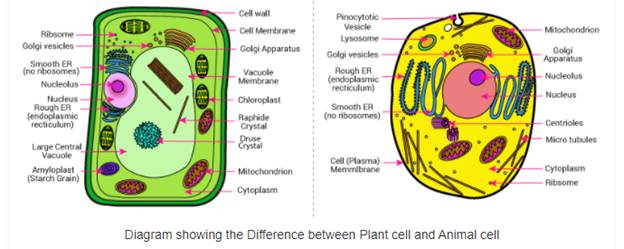
Difference Between Plant cell and Animal cell
The cell is the fundamental unit of life. All the life activities are carried out by cells. The organisms are classified based on the number of cells present in them. Unicellular organisms are single-celled, while multicellular organisms have a large number of cells.
Unicellular organisms are believed to be one of the earliest forms of life on earth. Eventually, more complex multicellular organisms evolved from these unicellular life forms over the aeons. Multicellular organisms have specialized cells with complicated cell organelles, which unicellular organisms typically lack.
In an ecosystem, plants have the role of producers while animals have taken the role of consumers. Hence, their daily activities and functions vary, so do their cell structure. Cell structure and organelles vary in plants and animals, and they are primarily classified based on their function. The difference in their cell composition is the reason behind the difference between plants and animals, their structure and functions.
Each cell organelle has a particular function to perform. Some of the cell organelles are present in both plant cell and the animal cell, while others are unique to just one. Most of the earth’s higher organisms are eukaryotes, including all plant and animals. Hence, these cells share some similarities typically associated with eukaryotes.
For example, all eukaryotic cells consist of a nucleus, plasma membrane, cytoplasm, peroxisomes, mitochondria, ribosomes and other cell organelles.

As stated above, both plant and animal cells share a few common cell organelles, as both are eukaryotes. The function of all these organelles is said to be very much similar. However, the major differences between the plant and animal cells, which significantly reflect the difference in the functions of each cell.
The major differences between the plant cell and animal cell are mentioned below:
Plant Cell | Animal Cell |
Cell Shape | |
Square or rectangular in shape | Irregular or round in shape |
Cell Wall | |
Present | Absent |
Plasma/Cell Membrane | |
Present | Present |
Endoplasmic Reticulum | |
Present | Present |
Nucleus | |
Present and lies on one side of the cell | Present and lies in the centre of the cell |
Lysosomes | |
Present but are very rare | Present |
Centrosomes | |
Absent | Present |
Golgi Apparatus | |
Present | Present |
Cytoplasm | |
Present | Present |
Ribosomes | |
Present | Present |
Plastids | |
Present | Absent |
Vacuoles | |
Few large or a single, centrally positioned vacuole | Usually small and numerous |
Cilia | |
Absent | Present in most of the animal cells |
Mitochondria | |
Present but fewer in number | Present and are numerous |
Mode of Nutrition | |
Primarily autotrophic | Heterotrophic |
Both plant and animal cells comprise membrane-bound organelles, such as endoplasmic reticulum, mitochondria, the nucleus, Golgi apparatus, peroxisomes, lysosomes. They also have similar membranes, such as cytoskeletal elements and cytosol. The plant cell can also be larger than the animal cell. The normal range of the animal cell varies from about 10 – 30 micrometres and that of plant cell range between 10 – 100 micrometres.